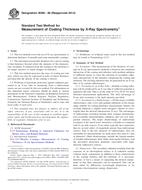Potrebujeme váš súhlas na využitie jednotlivých dát, aby sa vám okrem iného mohli ukazovať informácie týkajúce sa vašich záujmov. Súhlas udelíte kliknutím na tlačidlo „OK“.
ASTM G171-03(2009)e2
Standard Test Method for Scratch Hardness of Materials Using a Diamond Stylus (Includes all amendments And changes 12/7/2017).
Automaticky preložený názov:
Štandardná skúšobná metóda pre Scratch Tvrdosť materiálov pomocou Diamond Stylus
NORMA vydaná dňa 1.5.2009
Informácie o norme:
Označenie normy: ASTM G171-03(2009)e2
Poznámka: NEPLATNÁ
Dátum vydania normy: 1.5.2009
Kód tovaru: NS-57517
Počet strán: 7
Približná hmotnosť: 21 g (0.05 libier)
Krajina: Americká technická norma
Kategória: Technické normy ASTM
Kategórie - podobné normy:
Anotácia textu normy ASTM G171-03(2009)e2 :
Keywords:
scratch, scratch hardness, single-point abrasion, stylus, Ceramic materials/applications, Coating adhesion, Deformation--metals/alloys, Deformation resistance, Diamond stylus, Laboratory testing, Lubricated materials/testing, Metals and metallic materials, Polymers, Room temperature, Scratch testing, Single-point testing, Solid phase materials, Stylus drag coefficient, Unlubricated materials/testing, ICS Number Code 17.040.20 (Properties of surfaces)
Doplňujúce informácie
| Significance and Use | ||||
|
This test method is intended to measure the resistance of solid surfaces to permanent deformation under the action of a single point (stylus tip). It is a companion method to quasi-static hardness tests in which a stylus is pressed into a surface under a certain normal load and the resultant depth or impression size is used to compute a hardness number. Scratch hardness numbers, unlike quasi-static hardness numbers, involve a different combination of properties of the surface because the indenter, in this case a diamond stylus, moves tangentially along the surface. Therefore, the stress state under the scratching stylus differs from that produced under a quasi-static indenter. Scratch hardness numbers are in principle a more appropriate measure of the damage resistance of a material to surface damage processes like two-body abrasion than are quasi-static hardness numbers. This test method is applicable to a wide range of materials. These include metals, alloys, and some polymers. The main criteria are that the scratching process produces a measurable scratch in the surface being tested without causing catastrophic fracture, spallation, or extensive delamination of surface material. Severe damage to the test surface, such that the scratch width is not clearly identifiable or that the edges of the scratch are chipped or distorted, invalidates the use of this test method to determine a scratch hardness number. Since the degree and type of surface damage in a material may vary with applied load, the applicability of this test to certain classes of materials may be limited by the maximum load at which valid scratch width measurements can be made. The resistance of a material to abrasion by a single point may be affected by its sensitivity to the strain rate of the deformation process. Therefore, this test is conducted under low stylus traversing speeds. Use of a slow scratching speed also minimizes the possible effects of frictional heating. This test uses measurements of the residual scratch width after the stylus has been removed to compute the scratch hardness number. Therefore, it reflects the permanent deformation resulting from scratching and not the instantaneous state of combined elastic and plastic deformation of the surface. |
||||
| 1. Scope | ||||
|
1.1 This test method covers laboratory procedures for determining the scratch hardness of the surfaces of solid materials. Within certain limitations, as described in this guide, this test method is applicable to metals, ceramics, polymers, and coated surfaces. The scratch hardness test, as described herein, is not intended to be used as a means to determine coating adhesion, nor is it intended for use with other than specific hemispherically-tipped, conical styli. 1.2 The values stated in SI units are to be regarded as standard. No other units of measurement are included in this standard. 1.3 This standard may involve hazardous materials, operations, and equipment. This standard does not purport to address all of the safety concerns, if any, associated with its use. It is the responsibility of the user of this standard to establish appropriate safety and health practices and determine the applicability of regulatory limitations prior to use. |
||||
| 2. Referenced Documents | ||||
|
Podobné normy:
Historická
1.5.2014
Historická
1.10.2011
Historická
1.5.2014
Historická
1.5.2014
Historická
1.5.2014
Historická
1.11.2010
Odporúčame:
Aktualizácia technických noriem
Chcete mať istotu, že používate len platné technické normy?
Ponúkame Vám riešenie, ktoré Vám zaistí mesačný prehľad o aktuálnosti noriem, ktoré používate.
Chcete vedieť viac informácií ? Pozrite sa na túto stránku.



 ASTM B499-09(2014)..
ASTM B499-09(2014).. ASTM B504-90(2011)..
ASTM B504-90(2011).. ASTM B530-09(2014)..
ASTM B530-09(2014).. ASTM B567-98(2014)..
ASTM B567-98(2014).. ASTM B568-98(2014)..
ASTM B568-98(2014).. ASTM B588-88(2010)..
ASTM B588-88(2010)..
 Cookies
Cookies
